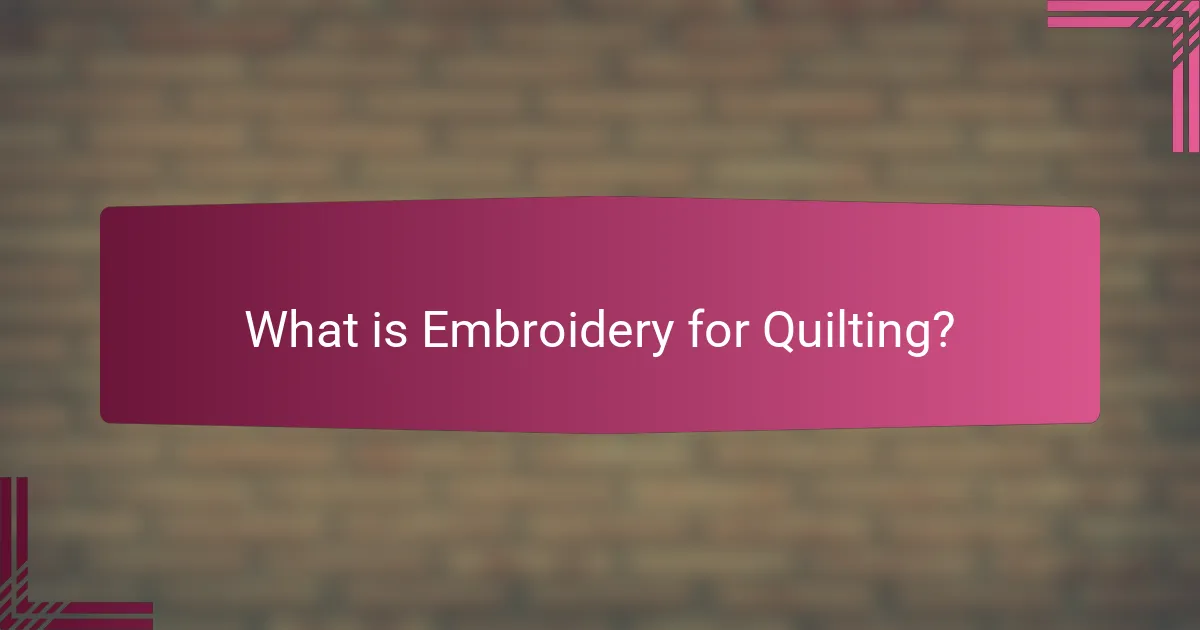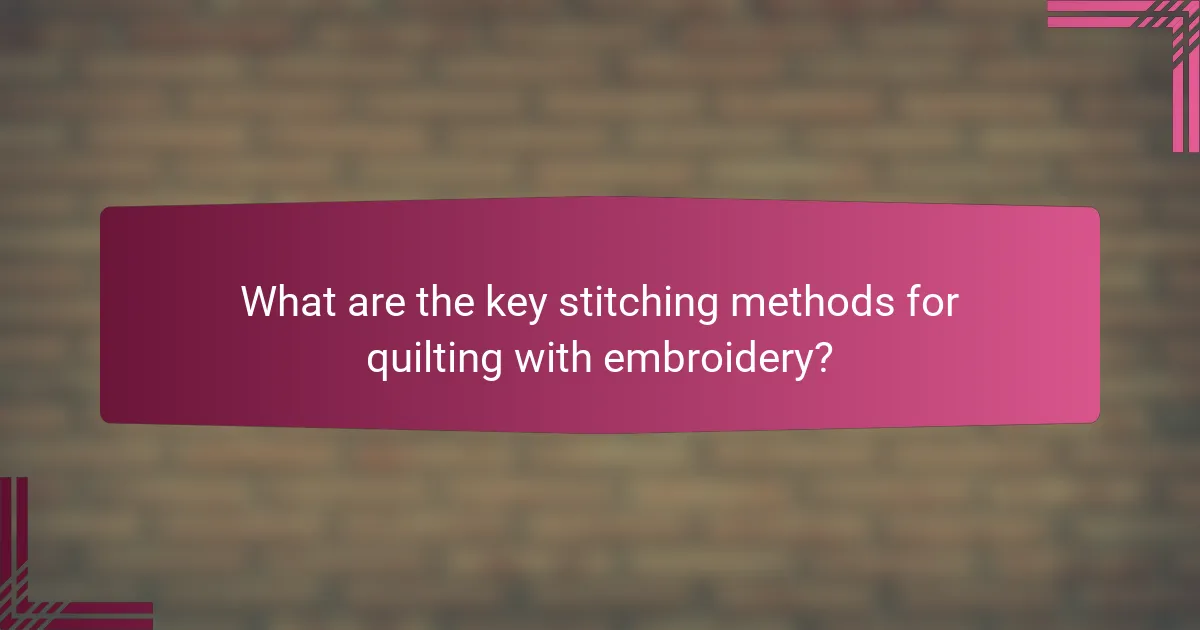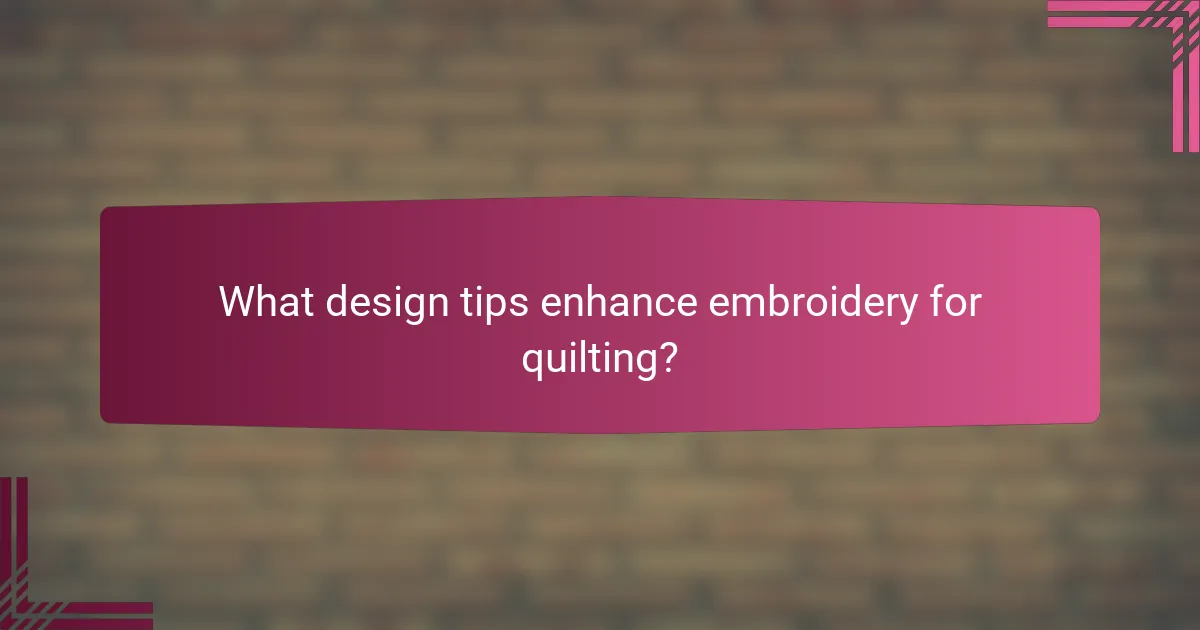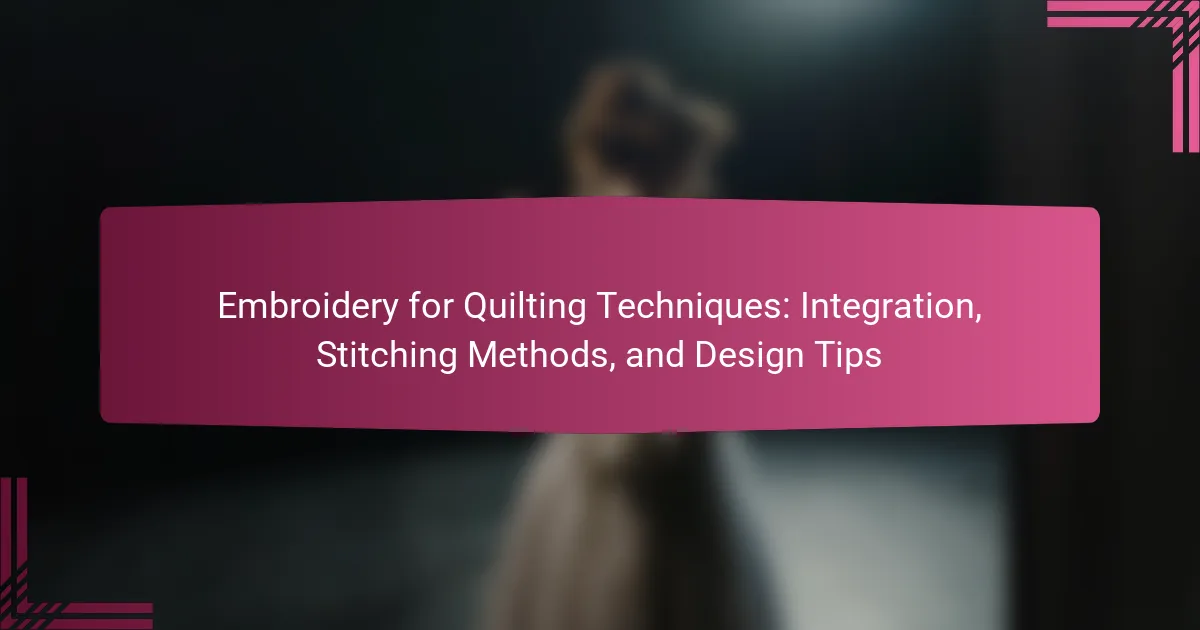
What is Embroidery for Quilting?
Embroidery for quilting is the process of decorating quilt fabric using needle and thread. This technique enhances the visual appeal of quilts. It can involve various stitching methods like appliqué, free-motion, or hand embroidery. Each method adds unique texture and detail to the quilt. Embroidery can also serve functional purposes, such as reinforcing seams. Historically, embroidery has been used in quilting for centuries, showcasing cultural artistry. Quilters often integrate embroidery to personalize their creations. This practice combines traditional craftsmanship with modern design.
How does embroidery enhance quilting projects?
Embroidery enhances quilting projects by adding intricate designs and textures. It provides visual interest and depth to the fabric. Embroidery can also personalize quilts, making them unique. This technique allows for the incorporation of various stitching methods, such as satin or chain stitches. These stitches can create patterns that complement the quilt’s overall design. Additionally, embroidery can reinforce seams and edges, improving durability. Studies show that embroidered quilts often have higher aesthetic value and emotional significance. This combination of beauty and functionality makes embroidery a valuable addition to quilting.
What types of embroidery techniques are commonly used in quilting?
Common embroidery techniques used in quilting include appliqué, hand embroidery, and machine embroidery. Appliqué involves stitching fabric shapes onto a quilt background. This technique adds dimension and design variety. Hand embroidery allows for intricate detailing and personalization. It often includes stitches like satin, chain, and French knots. Machine embroidery utilizes sewing machines to create designs quickly and uniformly. This method is efficient for larger projects. Other techniques include trapunto, which adds padding to create a raised effect, and cross-stitch, known for its distinctive grid pattern. Each technique enhances the visual appeal of quilts and showcases the quilter’s skills.
How does embroidery contribute to the overall design of a quilt?
Embroidery enhances the overall design of a quilt by adding texture and visual interest. It can create intricate patterns that complement the quilt’s fabric choices. Embroidered motifs often serve as focal points within the quilt. This technique allows for personalization, making each quilt unique. Additionally, embroidery can unify different fabric pieces by providing a cohesive theme. Historical quilting practices show that embroidery has been used for centuries to elevate quilt aesthetics. Studies indicate that quilts with embroidery often have higher perceived value and craftsmanship. Thus, embroidery significantly contributes to both the beauty and individuality of a quilt.
What are the historical origins of embroidery in quilting?
Embroidery in quilting has origins that date back to ancient civilizations. Historical evidence suggests that cultures in Egypt and China practiced embroidery as early as 3000 BCE. These early forms of embroidery were often used to embellish garments and household textiles.
In Europe, the practice gained prominence during the Middle Ages. Quilting, as a technique, became popular in the 14th century. Embroidery was integrated into quilting to enhance both aesthetic appeal and functionality.
The combination of embroidery and quilting became particularly significant in the 18th and 19th centuries. This era saw the creation of intricate quilt patterns featuring embroidered motifs. The American quilting tradition also reflects this integration, with many quilts showcasing both techniques.
Thus, the historical origins of embroidery in quilting are deeply rooted in various cultures, evolving over centuries to become a cherished craft.
How has the use of embroidery in quilting evolved over time?
The use of embroidery in quilting has evolved significantly over time. Initially, quilting primarily focused on piecing fabric together for warmth. Early quilts featured basic stitching techniques with minimal decorative elements. As time progressed, embroidery became a popular method to enhance the visual appeal of quilts.
By the 19th century, decorative embroidery techniques such as appliqué and sashiko gained prominence. These methods allowed quilters to add intricate designs and personal touches to their work. The Arts and Crafts movement further influenced quilting, encouraging more artistic expressions through embroidery.
In the 20th century, advancements in technology introduced machine embroidery. This innovation made it easier for quilters to incorporate detailed designs into their quilts. Today, a wide variety of embroidery techniques, including free-motion and computerized stitching, are commonly used in quilting.
The integration of embroidery in quilting continues to grow, reflecting contemporary trends and personal styles. Modern quilters often blend traditional and innovative embroidery techniques to create unique pieces.
What cultural influences shape embroidery techniques in quilting?
Cultural influences that shape embroidery techniques in quilting include regional traditions, historical events, and social practices. Different cultures have unique embroidery styles that reflect their heritage. For example, Mexican quilting often incorporates vibrant colors and intricate patterns. In contrast, Amish quilts emphasize simplicity and geometric designs. Historical events, such as migration, introduce new techniques and motifs into local quilting practices. Social practices, including communal sewing gatherings, foster the sharing of techniques and ideas. These influences collectively contribute to the diversity of embroidery techniques found in quilting today.

What are the key stitching methods for quilting with embroidery?
The key stitching methods for quilting with embroidery include straight stitching, zigzag stitching, and free-motion quilting. Straight stitching is commonly used for piecing quilt blocks and securing layers. Zigzag stitching adds decorative elements and helps prevent fraying on edges. Free-motion quilting allows for creative designs and patterns, enabling the quilter to control the stitching freely. Each method enhances the quilt’s aesthetics and durability. These techniques are widely recognized in quilting communities for their effectiveness in combining embroidery with quilting.
How do different stitching methods impact the final quilt design?
Different stitching methods significantly impact the final quilt design. Each method alters the texture, appearance, and durability of the quilt. For example, straight stitching creates clean lines and a polished look. It is often used for piecing quilt tops. In contrast, free-motion stitching adds intricate designs and a more artistic flair. This method allows for creative expression but may vary in consistency.
Additionally, hand quilting provides a unique, personal touch. It often results in a softer texture compared to machine quilting. Machine quilting, on the other hand, tends to be faster and can produce more uniform stitches. The choice of thread also influences the design. Thicker threads can create a bold look, while finer threads offer subtlety.
Ultimately, the selected stitching method shapes the overall aesthetic and functionality of the quilt. Each approach contributes to the quilt’s character and the intended use, whether decorative or practical.
What are the most popular stitching methods for quilting?
The most popular stitching methods for quilting include straight stitch, zigzag stitch, and free-motion quilting. Straight stitch is fundamental for piecing quilt blocks together. Zigzag stitch adds durability and prevents fabric fraying. Free-motion quilting allows for creative designs and patterns. Other notable methods are hand quilting, which provides a traditional look, and machine quilting, known for efficiency. Each method serves different purposes in quilt construction and design.
How can one choose the right stitching method for their project?
To choose the right stitching method for a project, first assess the fabric type and weight. Different fabrics require specific stitches to ensure durability and appearance. Next, consider the project’s purpose. For decorative projects, intricate stitches may enhance visual appeal. For functional items, sturdier stitches will provide longevity. Evaluate the skill level required for each method. Simpler stitches are better for beginners, while advanced techniques suit experienced crafters. Lastly, test different methods on fabric scraps. This allows for practical evaluation of the stitch’s effectiveness before committing to the final piece.
What tools and materials are essential for embroidery stitching in quilting?
Essential tools and materials for embroidery stitching in quilting include embroidery needles, thread, fabric, and scissors. Embroidery needles are designed with a larger eye to accommodate thicker threads. Thread used in embroidery often includes cotton or polyester, chosen for durability and colorfastness. Fabric should be suitable for quilting, such as cotton or linen, providing a sturdy base for stitching. Scissors are necessary for cutting threads and trimming fabric edges. Additionally, embroidery hoops help keep the fabric taut during stitching. These tools and materials are fundamental for achieving quality results in quilting embroidery.
What types of threads are best suited for quilting embroidery?
Cotton threads are best suited for quilting embroidery. They provide durability and a smooth finish. Cotton threads come in various weights, typically ranging from 30 to 50. Thicker threads like 30-weight are ideal for decorative stitches. Finer threads like 50-weight work well for detailed designs. Polyester threads are also popular due to their strength and colorfastness. They resist fading and shrinking, making them suitable for long-lasting quilts. Rayon threads add a glossy finish but may not be as durable as cotton or polyester. Overall, the choice of thread depends on the desired effect and the specific quilting technique used.
How do fabric choices affect embroidery techniques in quilting?
Fabric choices significantly influence embroidery techniques in quilting. Different fabrics have varying textures and weights. For instance, lightweight fabrics may require stabilizers to prevent distortion during embroidery. Heavier fabrics can support more intricate designs without additional support. The thread type also interacts with fabric choice; thicker threads work better on sturdier materials. Additionally, fabric color impacts thread visibility and overall design aesthetics. Choosing a compatible fabric ensures that the embroidery complements the quilt’s overall look. Specific studies show that fabric composition can affect stitch definition and durability.

What design tips enhance embroidery for quilting?
Use contrasting thread colors to make embroidery stand out on quilts. This technique draws attention to the design. Incorporate varied stitch types for texture and depth. Combining straight stitches with decorative stitches enhances visual appeal. Choose motifs that complement the quilt’s overall theme. Thematic designs create a cohesive look. Plan the layout before stitching to ensure balance. A well-thought-out arrangement improves the final presentation. Consider the fabric type when selecting thread and designs. Certain fabrics may require specific threads for optimal results.
How can one effectively integrate embroidery into quilt designs?
To effectively integrate embroidery into quilt designs, one should plan the layout carefully. Begin by selecting the quilt pattern that complements the embroidery. Choose colors in the embroidery that harmonize with the quilt fabric.
Next, decide on the embroidery techniques to use, such as appliqué or free-motion stitching. Incorporate the embroidery at strategic points in the quilt, like borders or focal areas.
Use a stabilizer to support the fabric during embroidery. This prevents distortion and maintains the quilt’s shape.
Finally, ensure that the embroidery threads are durable and colorfast to withstand washing. Following these steps enhances the overall aesthetic and functionality of the quilt.
What are the best practices for planning embroidery placement on quilts?
The best practices for planning embroidery placement on quilts include considering the quilt’s design and intended use. Start by selecting a focal point for the embroidery. This helps to draw attention and create visual interest. Use a grid system to ensure even spacing and alignment. Mark the placement with fabric-safe markers for accuracy. Consider the scale of embroidery in relation to the quilt blocks. Larger designs may require more space, while smaller designs can fit into tighter areas. Test the placement on a fabric scrap to visualize the final look. Additionally, ensure that the embroidery complements the quilt’s color scheme and overall theme.
How can color theory be applied to embroidery in quilting?
Color theory can be applied to embroidery in quilting by guiding the selection of thread colors and fabric patterns. Understanding color relationships can enhance visual appeal. For example, complementary colors create vibrant contrasts. Analogous colors provide harmony and subtlety. The color wheel is a valuable tool for quilters. It helps in choosing color schemes that evoke specific emotions. Studies show that color choices can influence viewer perception. Using color theory effectively can elevate the overall design of a quilt.
What common mistakes should be avoided when combining embroidery and quilting?
Common mistakes to avoid when combining embroidery and quilting include not using compatible fabrics. Using fabrics that have different weights can lead to puckering and distortion. Another mistake is neglecting to stabilize the fabric properly. Stabilizers help maintain the fabric’s structure during embroidery. Additionally, failing to choose the right thread can result in breakage or uneven stitching. Using a thread that is too thick or too thin for the fabric can create issues. Not planning the design layout is also a frequent error. A well-thought-out layout prevents overlapping and ensures balanced aesthetics. Lastly, skipping test stitches can lead to unexpected results. Testing on a scrap piece allows for adjustments before the final project.
How can one troubleshoot issues that arise during the embroidery process?
To troubleshoot issues during the embroidery process, first identify the specific problem. Common issues include thread breakage, uneven stitches, and design misalignment. For thread breakage, check the thread tension and ensure the needle is appropriate for the fabric type. Uneven stitches may indicate incorrect hooping or a dirty machine, which should be cleaned regularly. Misalignment of designs can be resolved by verifying the placement on the fabric before starting the embroidery. Additionally, using stabilizers can help prevent puckering and improve stitch quality. Following these steps can effectively address and resolve common embroidery issues.
What are some tips for achieving professional-looking embroidery on quilts?
To achieve professional-looking embroidery on quilts, use high-quality embroidery thread. Quality thread enhances the overall appearance and durability of the design. Choose a stabilizer that matches the fabric type. This prevents distortion during stitching. Use an embroidery hoop to keep the fabric taut. A taut fabric ensures even stitches and precision. Select a needle appropriate for the thread and fabric. This reduces the risk of thread breakage and fabric damage. Practice your stitching technique on scrap fabric. This helps refine your skills before working on the quilt. Lastly, pay attention to color coordination. Harmonious colors create a cohesive and professional look.
What are the latest trends in embroidery for quilting?
The latest trends in embroidery for quilting include the use of digital embroidery machines. These machines allow for intricate designs and faster production. Another trend is the incorporation of mixed media, combining traditional embroidery with fabrics like leather or felt. Hand embroidery is also gaining popularity, offering a personal touch to quilts. Sustainable materials are trending, with quilters using organic fabrics and eco-friendly threads. Additionally, bold colors and geometric patterns are becoming more prevalent in quilt designs. Lastly, technology integration, such as software for design customization, is on the rise. These trends reflect a blend of tradition and innovation in the quilting community.
Embroidery for quilting is a decorative technique that enhances quilt fabric using various stitching methods, including appliqué, free-motion, and hand embroidery. This article explores how embroidery adds texture, visual interest, and personalization to quilting projects. It covers common embroidery techniques, the historical evolution of embroidery in quilting, and cultural influences on stitching methods. Additionally, it provides practical tips on choosing the right stitching methods, tools, and materials, as well as design strategies to achieve professional results. The latest trends in embroidery for quilting are also highlighted, showcasing the integration of traditional craftsmanship with modern innovations.
